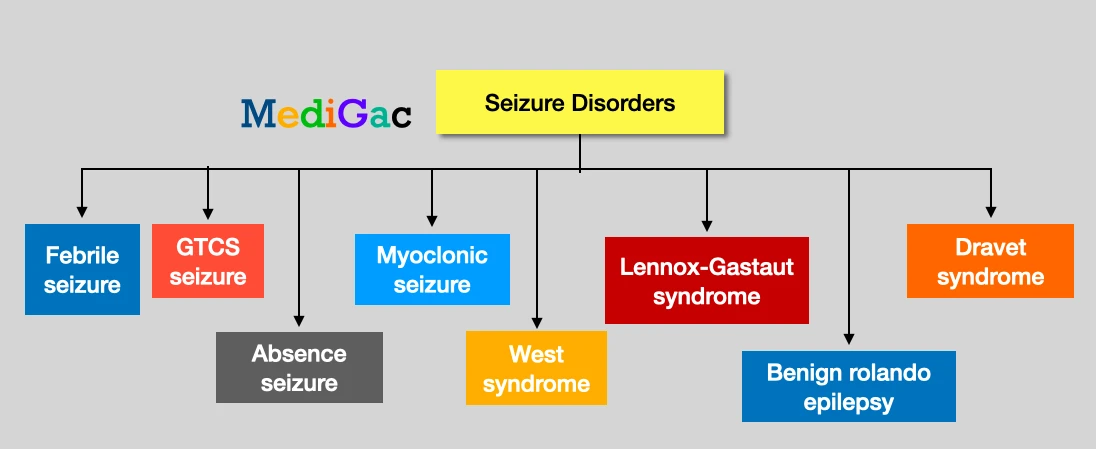
In Paediatrics Neurological diseases, Seizure related disorders are :
- Febrile Serzure
- GTCS
- Absense seizure
- Myoclonic seizure
- West syndrome
- Lennox-Gastaut syndrome
- Benign Rolandic epilepsy
- Dravet syndrome
1. Febrile seizure :
A febrile seizure is a convulsion produced by a fever in a child. A fever is frequently caused by an infection. Febrile seizures affect young, healthy youngsters who are developing normally and have never had any neurological problems. When your child experiences a febrile seizure, it might be scary.
Presenting clinical features :
- Vomiting.
- A hunchback.
- Breathing difficulties.
- Extreme drowsiness
2. GTCS seizure :
Tonic-clonic seizure with generalised tonic-clonic convulsions (GTC). There are phases to a GTC, or grand mal seizure. This seizure is presented by five stages and those five stages contains the clinical features.
Presenting clinical features based on five stages :
- The body, arms, and legs will flex (contract)
- Extend (straighten out)
- Tremor (shake)
- Clonic period (muscle contraction and relaxation)
- Postictal period will occur.
3. Absence seizure :
You will blank out or look into space for a few seconds during an absence seizure. Petit mal seizures are another name for them. Children are the most commonly affected by absence seizures, which usually do not result in long-term complications. A period of hyperventilation is frequently associated with these convulsions.
Presenting clinical features :
- Without falling, a sudden halt in motion is achieved.
- Lips are licking.
- The fluttering of the eyelids.
- Motions of chewing
- Fingers rubbing together.
- Both hands make small movements.
4. Myoclonic seizure :
Myoclonic seizures are short jerks of a muscle or set of muscles that resemble a shock. They can be found in a number of epilepsy syndromes, each with its own set of symptoms. The person is normally conscious and able to think clearly throughout a myoclonic seizure.
Presenting clinical features :
- Neck.
- Shoulders.
- Arms and shoulders.
5. West syndrome :
West syndrome is a group of symptoms that includes epileptic/infantile spasms, hypsarrhythmia (abnormal brain wave patterns), and intellectual impairment.
Presenting clinical features :
- Spasms in the epileptic or infantile brain,
- Hypsarrhythmia (abnormal brain wave patterns), and intellectual disabilities
6. Lennox-Gastaut syndrome :
Lennox-Gastaut syndrome (LGS) is a severe form of epilepsy that usually manifests in early childhood or infancy. Affected children have a variety of seizures, the most common of which are atonic, tonic, and atypical absence seizures.
Presenting clinical features :
- The term “tonic” refers to a substance that helps the body harden.
- Atonic – a condition in which the patient’s muscle tone and consciousness are temporarily lost, causing them to fall.
- Staring episodes are atypical absences.
- Myoclonic jerks are muscle jerks that occur suddenly.
7. Benign rolandic epilepsy :
The most prevalent type of infantile epilepsy is benign rolandic epilepsy (BRE). Because most children outgrow the ailment by puberty, it is referred regarded as “benign.” Seizures involving the rolandic region of the brain are characteristic of this type of epilepsy.
Presenting clinical features :
- Twitching,
- Numbness, or tingling of the child’s face or tongue, which can induce drooling and difficulty with speech.
8. Dravet syndrome :
Dravet syndrome is a rare, drug-resistant epilepsy that strikes an otherwise healthy infant in the first year of life. It lasts a lifetime. A protracted seizure with a temperature on one side of the body is the most common symptom. The majority of cases are caused by mutations in the SCN1A gene.
Presenting clinical features :
- Hyperthermia
- Speech difficulty
- Ataxia
- Hypotonia
- Developmental delays
- Sleep disorders, and other health issues are all common.